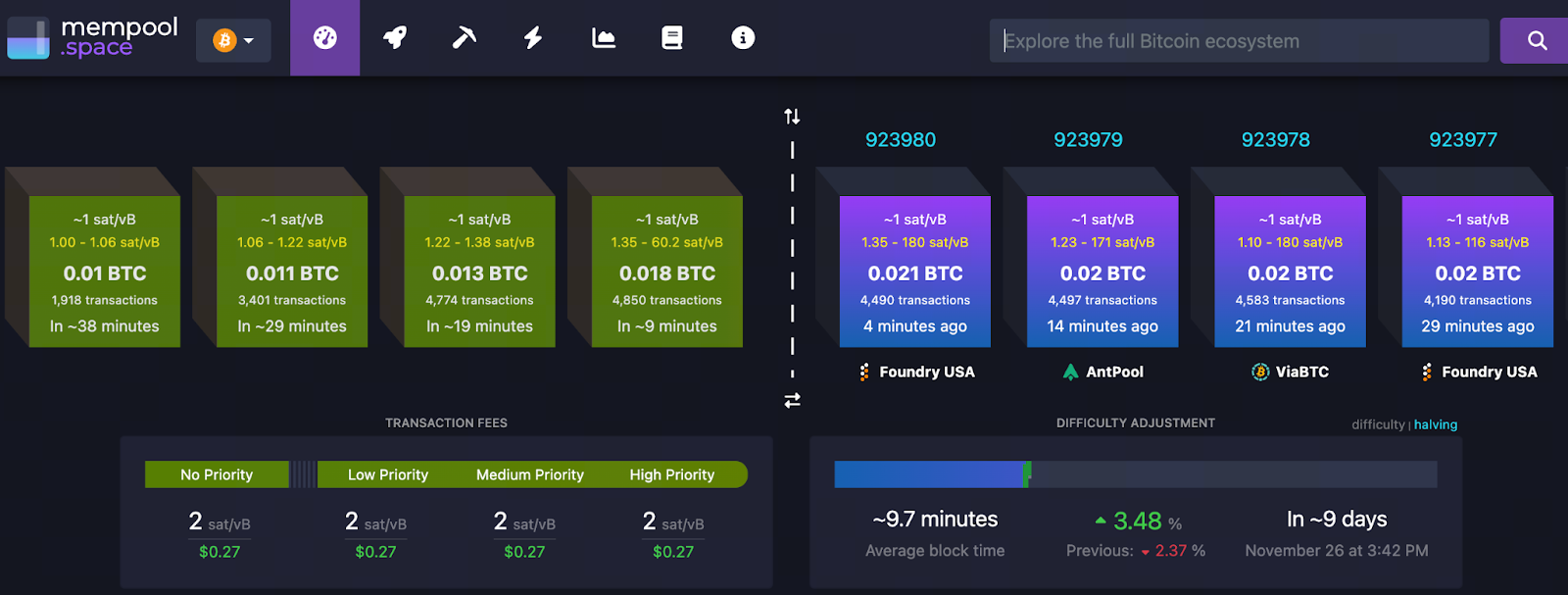Bitcoin Mempool Empties Again: Technology and Risks Behind the Reduced Network Congestion
What Is Mempool?
First, let’s define “mempool.” The mempool, short for memory pool, is the temporary storage area where blockchain nodes hold unconfirmed transactions. In practice, when you submit a transaction to the Bitcoin network, it first enters the mempool on different nodes, waiting for miners to include it in a new block. Each node maintains its own mempool, and their contents may vary since nodes receive transactions at different times and have different memory settings.
Latest Update: Bitcoin Mempool Nearly Empty

Source: https://mempool.space/
Recent data indicates that the Bitcoin network’s mempool is almost empty. Multiple media outlets have highlighted that this extremely low backlog of transactions signals weak on-chain demand. This has attracted significant attention in the crypto community, since, under normal conditions of high activity or network congestion, the mempool typically fills with a large number of unconfirmed transactions.
Why the Mempool Is Empty: Low Transaction Activity and Retail Absence
Why is the mempool so empty? Some analysts link it directly to a sharp drop in retail investor activity. When retail trading subsides, on-chain transactions decrease, leading to fewer new transactions entering the mempool. Additionally, the market may be in a holding pattern—many users are waiting for key events or price volatility before transferring funds.
Technical Risk: Node Configuration and Disabling the Mempool
In addition to the decline in transactions, there are also technical risks to consider. BitMEX Research has reported that some node operators are considering disabling mempool functionality. While this can save memory resources, it poses risks: nodes may not relay all unconfirmed transactions. This could undermine the decentralized nature of Bitcoin and slow transaction confirmations. These discussions show that, as on-chain activity drops, node operators are increasingly focused on resource optimization. They are also paying closer attention to network stability.
Irregular Block Intervals: Longer Block Times as a Signal
More concerning is that the Bitcoin network recently saw a block interval exceeding 77 minutes, based on mempool statistics. Normally, Bitcoin produces a new block every 10 minutes on average. Extended block times can reflect reduced miner participation, changes in miner activity, or instability in hash rate.
Impact on Network Health and Miner Revenue
- Network Health: An almost empty mempool may signal weak network demand, undermining the decentralized nature of Bitcoin. If nodes disable mempool functionality for resource reasons, the network’s ability to relay transactions could weaken further.
- Miner Revenue: Transaction fees are crucial for miner income. If transaction volume falls and the mempool remains empty, miners may face decreased fee revenue.
Summary and Outlook
The near-empty Bitcoin mempool highlights weak on-chain activity and low retail participation. Additionally, changes in node configurations and irregular block intervals highlight ongoing network risks during periods of low demand. If transaction activity increases, new transactions will fill the mempool again. However, if node operators continue to disable mempool functionality to conserve resources, the network’s decentralization could be impacted over time. Monitoring these trends can help users evaluate network health, transaction confirmation times, and fee structures.
Related Articles

Pi Coin Transaction Guide: How to Transfer to Gate.io

Flare Crypto Explained: What Is Flare Network and Why It Matters in 2025

How to Use a Crypto Whale Tracker: Top Tool Recommendation for 2025 to Follow Whale Moves

What is N2: An AI-Driven Layer 2 Solution

2025 BTC Price Prediction: BTC Trend Forecast Based on Technical and Macroeconomic Data
